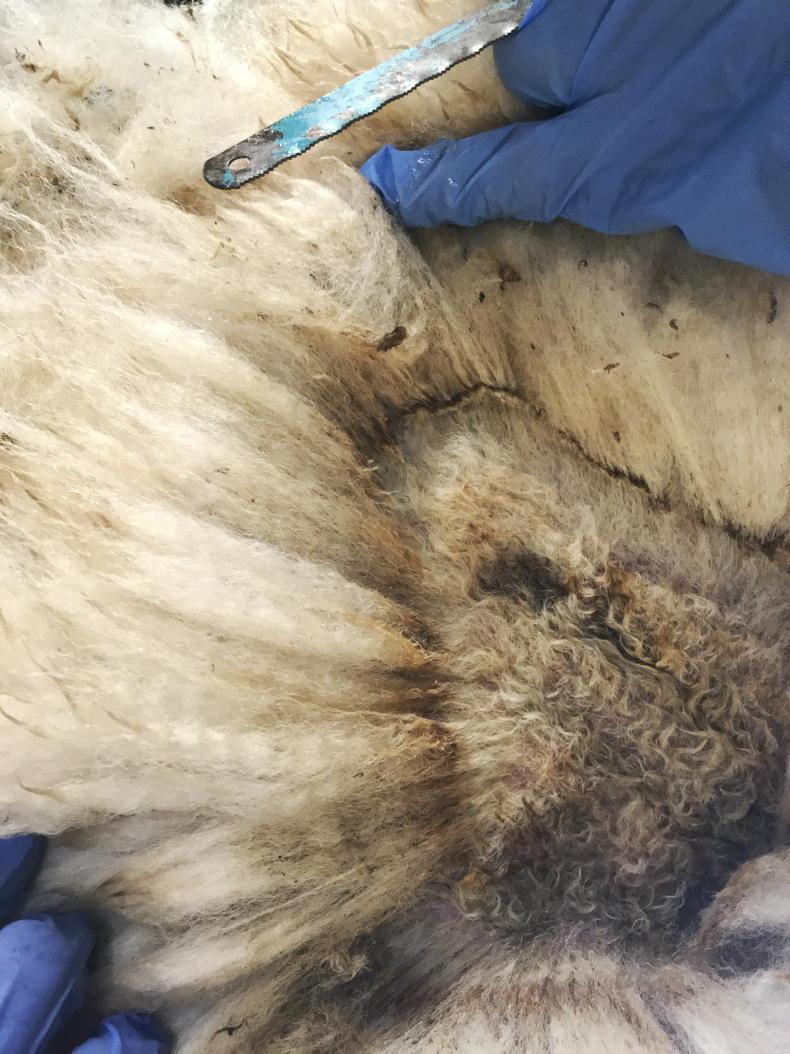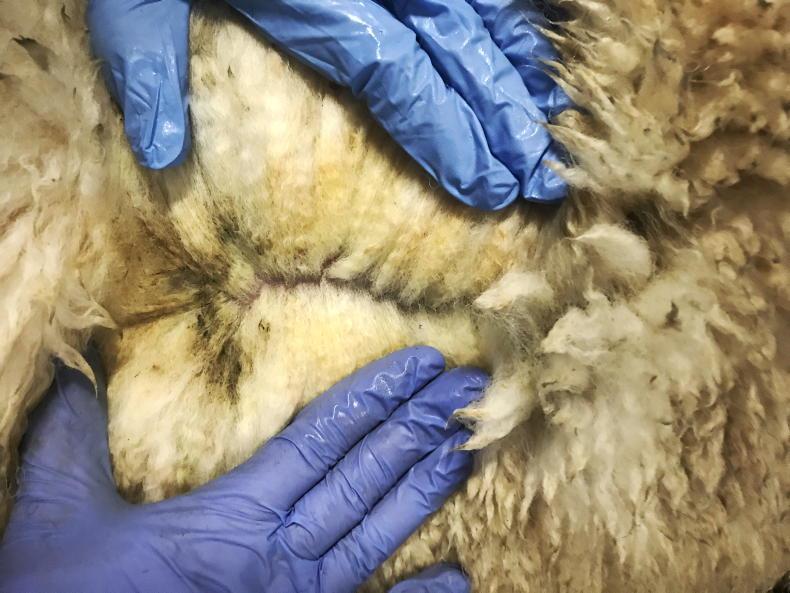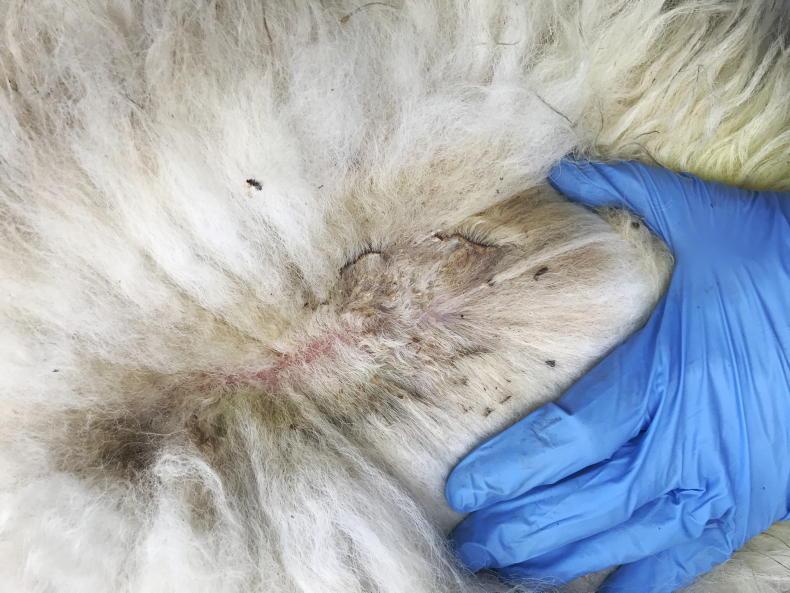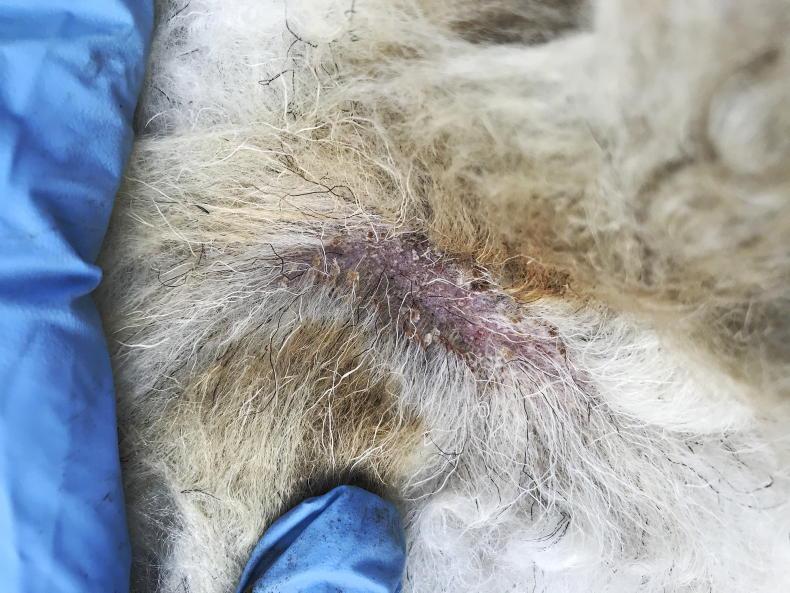As reported in this week’s management notes, the adverse weather is showing up external parasite issues in sheep much quicker.
The common perpetrators at this stage of the year are sheep scab and lice, with the latter now seen as a significant issue for many flocks.
However, some farmers, vets and those working in antiparasitic medicines have reported issues with sheep scratching, despite being treated satisfactorily for a broad range of external parasites.
On further veterinary investigation, the underlying cause was, in some cases, identified as bacterial skin infections.
The most common ailment here is mycotic dermatitis, which has many other names among farmers, including rain scald, lumpy wool disease or dermatophilosis.
The following piece was put together in December 2020 when conditions were also similar to now, with above-normal temperatures and sustained rainfall.
Growing issue
As one of the names suggests, the condition is linked to the fleece and skin of sheep being persistently wet. This dermatitis skin condition in sheep can give rise to secondary infections.

Individual sheep can experience balding where lumps of wool are removed through scratching.
One infection is caused by a bacteria, dermatophilus. This is regularly present on the skin of sheep without causing any issues, as the skin has a protective layer topped up by secretion from sweat glands.
Damage to the skin’s surface through management tasks such as shearing, rough animal handling and damage caused by external parasites can provide a route of entry for infection to establish.
What is thought to be a more common contributor in recent years is the fleece and skin of sheep being continually wet or moist under warm conditions.
A growing trend of persistent rainfall during the months of July, August and September is leaving little chance for the fleece and skin of sheep to dry, while moist warm conditions allow bacteria to multiply rapidly.

Sheep generally recover on their own in three to four weeks and most sheep which experience a low-level infection do not exhibit signs of scratching or irritation with no effect on animal health or performance.
Continual moisture on the skin is linked to a breakdown in the normal protective layer, while other theories also raise the possibility of a higher risk of infection when a prolonged spell of hot, dry weather is followed by persistent rainfall.
This is due to the skin of sheep possibly becoming damaged by sunlight or higher than normal temperatures post-shearing (where shelter is limited), with the infection then establishing and spreading during wet, clammy weather.
It is not generally a problem during periods of low temperatures and hence is the reason why it has not been a big problem in the past during more traditional weather cycles of a cold or wet late-autumn/winter period.
Characteristic signs
The condition triggers an immune response, with the skin naturally fighting back by secreting liquid, which thickens and forms a coat at the base of the wool.
The dermatophilus bacteria take advantage and multiply with a continuous cycle of inflammatory exudate being secreted and drying out. It has a colour-like appearance to brown sugar and can be seen by parting the wool.

Characteristic signs of mycotic dermatitis developing including inflammation of the skin and a brown exudate on the wool.
It is most common over the back, flanks and upper surfaces of the body. However, it can establish on the lower legs.
Alternatively, it can occur as flaky scabs or scales on the face or ears of sheep where it is of no clinical significance except it can be a source of bacterial spores for spread to other sheep.
In severe cases, it can form a crust and result in wool becoming matted and lumpy at various levels, hence the name lumpy wool. Individual sheep can experience balding where lumps of wool are removed through scratching.
Treatment options
Sheep generally recover on their own in three to four weeks and most sheep which experience a low-level infection do not exhibit signs of scratching or irritation, with no effect on animal health or performance.
Veterinary advice usually recommends a course of three to four treatments of antibiotics (penicillin or oxytetracycline) over a week to 10 days. Clinical diagnosis is vital, as other causes such as fungal infection can be present.
It can take the affected area five to six weeks, or longer, to return to normal. Many reports highlight the use of dipping with zinc or aluminium salts, but these are more targeted at controlling the spread and do not treat an active infection.
Veterinary advice is useful, as skin scrapings can be collected to confirm that it is in fact dermatophilus that is present. It is also important when investigating any such ailment to rule out the most common causes, such as lice and scab.
Read more
Sheep Management: dealing with external parasite issues in sheep
As reported in this week’s management notes, the adverse weather is showing up external parasite issues in sheep much quicker.
The common perpetrators at this stage of the year are sheep scab and lice, with the latter now seen as a significant issue for many flocks.
However, some farmers, vets and those working in antiparasitic medicines have reported issues with sheep scratching, despite being treated satisfactorily for a broad range of external parasites.
On further veterinary investigation, the underlying cause was, in some cases, identified as bacterial skin infections.
The most common ailment here is mycotic dermatitis, which has many other names among farmers, including rain scald, lumpy wool disease or dermatophilosis.
The following piece was put together in December 2020 when conditions were also similar to now, with above-normal temperatures and sustained rainfall.
Growing issue
As one of the names suggests, the condition is linked to the fleece and skin of sheep being persistently wet. This dermatitis skin condition in sheep can give rise to secondary infections.

Individual sheep can experience balding where lumps of wool are removed through scratching.
One infection is caused by a bacteria, dermatophilus. This is regularly present on the skin of sheep without causing any issues, as the skin has a protective layer topped up by secretion from sweat glands.
Damage to the skin’s surface through management tasks such as shearing, rough animal handling and damage caused by external parasites can provide a route of entry for infection to establish.
What is thought to be a more common contributor in recent years is the fleece and skin of sheep being continually wet or moist under warm conditions.
A growing trend of persistent rainfall during the months of July, August and September is leaving little chance for the fleece and skin of sheep to dry, while moist warm conditions allow bacteria to multiply rapidly.

Sheep generally recover on their own in three to four weeks and most sheep which experience a low-level infection do not exhibit signs of scratching or irritation with no effect on animal health or performance.
Continual moisture on the skin is linked to a breakdown in the normal protective layer, while other theories also raise the possibility of a higher risk of infection when a prolonged spell of hot, dry weather is followed by persistent rainfall.
This is due to the skin of sheep possibly becoming damaged by sunlight or higher than normal temperatures post-shearing (where shelter is limited), with the infection then establishing and spreading during wet, clammy weather.
It is not generally a problem during periods of low temperatures and hence is the reason why it has not been a big problem in the past during more traditional weather cycles of a cold or wet late-autumn/winter period.
Characteristic signs
The condition triggers an immune response, with the skin naturally fighting back by secreting liquid, which thickens and forms a coat at the base of the wool.
The dermatophilus bacteria take advantage and multiply with a continuous cycle of inflammatory exudate being secreted and drying out. It has a colour-like appearance to brown sugar and can be seen by parting the wool.

Characteristic signs of mycotic dermatitis developing including inflammation of the skin and a brown exudate on the wool.
It is most common over the back, flanks and upper surfaces of the body. However, it can establish on the lower legs.
Alternatively, it can occur as flaky scabs or scales on the face or ears of sheep where it is of no clinical significance except it can be a source of bacterial spores for spread to other sheep.
In severe cases, it can form a crust and result in wool becoming matted and lumpy at various levels, hence the name lumpy wool. Individual sheep can experience balding where lumps of wool are removed through scratching.
Treatment options
Sheep generally recover on their own in three to four weeks and most sheep which experience a low-level infection do not exhibit signs of scratching or irritation, with no effect on animal health or performance.
Veterinary advice usually recommends a course of three to four treatments of antibiotics (penicillin or oxytetracycline) over a week to 10 days. Clinical diagnosis is vital, as other causes such as fungal infection can be present.
It can take the affected area five to six weeks, or longer, to return to normal. Many reports highlight the use of dipping with zinc or aluminium salts, but these are more targeted at controlling the spread and do not treat an active infection.
Veterinary advice is useful, as skin scrapings can be collected to confirm that it is in fact dermatophilus that is present. It is also important when investigating any such ailment to rule out the most common causes, such as lice and scab.
Read more
Sheep Management: dealing with external parasite issues in sheep









 This is a subscriber-only article
This is a subscriber-only article










SHARING OPTIONS: